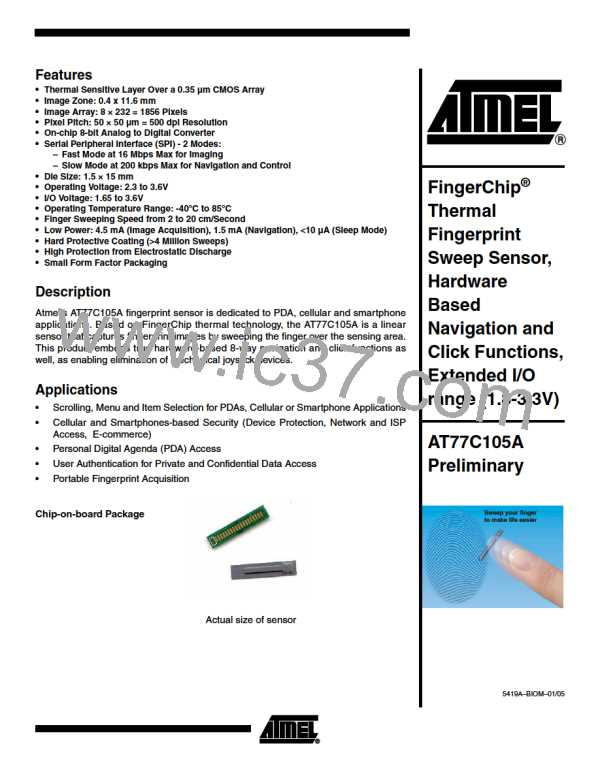AT77C105A [Preliminary]
Navigation
See “Navigation Register” on page 20.
The typical navigation slice frequency has been fixed to 2.9 kHz. A programmable
divider is implemented in the control registers (NAVFREQ) to reduce this frequency.
Finger displacement is provided as a number of pixels in X and Y directions. Negative
movements are possible. The register is cleared after the navigation registers are read.
These registers are incremented or decremented between two accesses.
Table 18.
Navctrl
Register
Typical Navigation
Slice Frequency
(kHz)
Typical
Integration Time
(µs)
Typical Maximum
Finger Speed
(cm/s)
(Bits b6 to b5)
00
01
10
11
5.8
2.9
1.9
1.5
172
345
526
666
30
15
9.5
7.5
Click
See “Clickctrl Register” on page 18.
The sensor generates a click detection. The host must read the b7 bit of the status reg-
ister or the b1 bit of the general navigation register.
The click function is composed of an array of a few pixels and a processing unit. The
typical click slice frequency is 90 Hz. A programmable divider is implemented to modify
this frequency in the control registers (CLICKFREQ).
Double-click
This function is performed by the controller, allowing better flexibility. It detects a suc-
cession of two clicks.
Temperature Stabilization Function and Watchdog
The sensor has an embedded temperature stabilization unit that identifies a difference
in temperature between the finger and the sensor. When this difference is increased, the
images are more contrasted. This function is optional and its use depends on the quality
of the image processing software, therefore its management should be decided together
with the image processing software.
In order to limit excessive current consumption by the use of the temperature stabiliza-
tion function, a watchdog has been implanted in the sensor. The local oscillator stops
the heating of the module after a defined time. The oscillator should not be stopped as
long as watchdog is active, otherwise the clock stops automatically.
When heating of the sensor is requested “1” is written in bit 6 of the HEATCTRL
register) and the watchdog is enabled “1” is written in bit 5 of the HEATCTRL register),
the sensor is heated during ‘n’ seconds.
Due to the oscillator frequency dispersion, the value of n is:
2 seconds (minimum) < n = 4 seconds (typical) < 7 seconds (maximum).
The accuracy of n is not important since the heat register can be enabled successively.
The level of power consumption is programmable. Two pre-programmed values are set
to 50 or 100 mW.
31
5419A–BIOM–01/05

 ATMEL [ ATMEL ]
ATMEL [ ATMEL ]